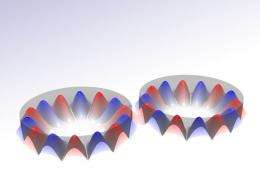Scientists predict paradoxical laser effect

New laser-effect, discovered by scientists from the Vienna University of Technology, Princeton, Yale and ETH Zurich: If coupled, lasers can switch each other off, leading to a "laser blackout".
Two lamps are brighter than one. This simple truism does not necessarily apply to lasers, as a team of scientists, led by the Vienna University of Technology found out. When one laser is shining and next to it another laser is turned on gradually, complex interactions between the two lasers can lead to a total shutdown and no light is emitted anymore. For technologies connecting the fields of electronics and photonics, this result may be very important. The new findings have now been published in the journal Physical Review Letters.
“Imagine two light bulbs right next to each other, one of which is switched on. As you gradually turn on the second bulb by adjusting a dimmer switch, you expect the room to get brighter”, says Matthias Liertzer. He studied the behavior of coupled micro-lasers using computer simulations, together with Professor Stefan Rotter at the Institute for Theoretical Physics (TU Vienna). They were assisted by scientists from Princeton University, Yale University and the ETH Zurich.
To make a laser shine, it has to be “pumped” – it has to be supplied with energy, using light or electric current. If only one of two micro-lasers is pumped, only the pumped laser emits light. Surprisingly, pumping the second laser too does not necessarily increase the brightness of the coupled system. Supplying more energy can even reduce the brightness, until both lasers become dark. “When we saw that the two lasers can switch each other off completely, due to the coupling between them, we knew: either we made a mistake or this is a spectacular result”, says Stefan Rotter. In the meantime, the effect was confirmed in independent calculations by the co-authors from Yale.
Light consists of waves, and it is well known that waves can interfere and cancel each other out. The interplay between the two lasers, however, is more complicated than that: “This effect is not just about wave interference. It is a combination of interference and light amplification, which can lead to seemingly paradoxical effects”, says Matthias Liertzer. New methods, some of which were developed by mathematicians at TU Vienna, were necessary to solve the complicated equations which describe this problem. “The phenomenon is based on what mathematicians call exceptional points”, says Stefan Rotter. Exceptional points are special intersections of surfaces in complex spaces. “The appearance of such exceptional points in our laser equations can lead to a laser blackout. In this way we could connect a rather abstract mathematical structure to a measurable phenomenon”, says Rotter.
Electrical engineers at the Vienna University of Technology are now working on experiments with micro lasers, in which the theoretical predictions should be verified. Laser effects like this one are especially interesting, as they show new ways to connect microelectronics and laser technology. In today’s computers, information is transmitted by electric signals. Adding laser light could open up exciting new possibilities.
More information: prl.aps.org/abstract/PRL/v108/i17/e173901 , Free arxiv version: arxiv.org/abs/1109.0454
Provided by Vienna University of Technology




















